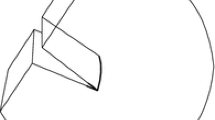Abstract
Crack growth initiation and subsequent resistance to propagation are explored numerically for regular and irregular hexagonal honeycomb structures made from ductile cell walls. The elasto-plastic response of the cell walls is described by a bilinear uniaxial stress-strain law, with fracture of the cell walls characterised by the fracture energy per unit area. Estimates for the macroscopic toughness and the associated plastic zone shape are derived analytically on the basis of simple considerations. Crack propagation is simulated numerically by fracturing elements within a finite element model and K-resistance curves are calculated under the assumption of small-scale yielding. The dependence of the crack growth behaviour upon the cell wall material parameters and geometric imperfections of the structure is investigated.
Similar content being viewed by others
References
Ashby, M., Evans, A., Fleck, N., Gibson, L., Hutchinson, J., and Wadley, N. (2000). Metal Foams – a Design Guide. Butterworth, Heinemann, Boston, USA.
Chen, C., Lu, T.J., and Fleck, N.A. (1999). Effect of imperfections on the yielding of two-dimensionals foams. Journal of the Mechanics and Physics of Solids 47, 2235–2272.
Chen, J.Y. and Huang, J.S. (1998). Fracture analysis of cellular materials: a strain gradient model. Journal of the Mechanics and Physics of Solids 46, 789–828.
Choi, J.B. and Lakes, R.S. (1996). Fracture toughness of re-entrant foam materials with a negative Poisson's ratio: experiment and analysis. International Journal of Fracture 80, 73–83.
Deshpande, V.S. and Fleck, N.A. (2000). Isotropic constitutive models for metallic foams. Journal of the Mechanics and Physics of Solids 48, 1253–1283.
Gibson, L.J. and Ashby, M.F. (1998). Cellular Solids. Pergamon Press, London.
Hallström, S. and Grenestedt, J. (1997). Mixed mode fracture of cracks and wedge shaped notches in expanded PVC foam. International Journal of Fracture 88, 343–358.
Huang, J.S. and Gibson, L.J. (1991a). Fracture toughness of brittle foams. Acta Metall. Mater. 39, 1627–1636.
Huang, J.S. and Gibson, L.J. (1991b). Fracture toughness of brittle honeycombs. Acta Metall. Mater. 39, 1617–1626.
Miller, R. (2000). A continuum plasticity model of the constitutive and indentation behavior of foamed metals. International Journal of Mechanics Sciences 42, 729–754.
Author information
Authors and Affiliations
Rights and permissions
About this article
Cite this article
Schmidt, I., Fleck, N. Ductile fracture of two-dimensional cellular structures – Dedicated to Prof. Dr.-Ing. D. Gross on the occasion of his 60th birthday. International Journal of Fracture 111, 327–342 (2001). https://doi.org/10.1023/A:1012248030212
Issue Date:
DOI: https://doi.org/10.1023/A:1012248030212




